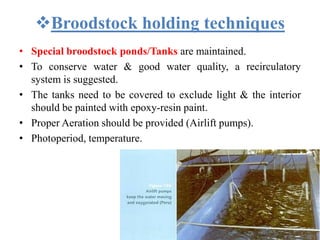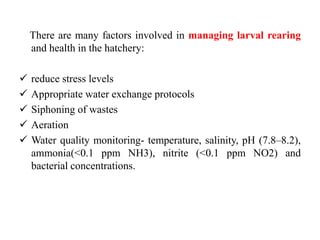Broodstock nd hatchery management
- 1. BROODSTOCK AND HATCHERY MANAGEMENT OF Penaeus monodon SHRUTI GUPTA NCAAH
- 2. Penaeus monodon • Marine crustacean. • Its natural distribution : Indo-Pacific, ranging from the eastern coast of Africa and the Arabian Peninsula, as far as Southeast Asia, the Sea of Japan, and northern Australia. • Females can reach approximately 33 centimetres long. • Males are slightly smaller at 20– 25 cm long. • Life span= 1-2 yrs.
- 3. BIONOMICS & LIFE HISTORY Lateral view of P. monodon showing important parts
- 4. Life history of P. monodon
- 5. MALE REPRODUCTIVE ORGAN FEMALE REPRODUCTIVE ORGAN PETASMA THELYCUM
- 6. • Penaeus monodon is the most widely cultured prawn species in the world.
- 7. India has significant potential for aquaculture development, of the 1 190 900 ha of land available for shrimp aquaculture, the current area under culture is about 155 000 ha.
- 8. BROODSTOCK MANGEMENT • Broodstock, are a group of mature individuals used in aquaculture for breeding purposes. • Broodstock management involves manipulating environmental factors. • Major advantage : Holding broodstock in an accessible pond or tank offers readily available breeding adults whenever required.
- 9. HATCHERY DEVELOPMENT • A hatchery is a resource where eggs are incubated and hatched. • In a hatchery mostly care for the young animals in their first few days or weeks of life is taken, until they are healthy and old enough to be shipped to another location. • Hatchery development involves cultivation and breeding of large number of fishes in an enclosed environment.
- 11. THE OVERALL BROODSTOCK &HATCHERY MANAGEMENT IN P. monodon CAN BE DIVIDED INTO 2 BROAD CATEGORIES: Pre- spawning procedures Broodstock capture/ selection Brooder maintenance/Nutrition Broodstock holding /managing techniques Broodstock maturation Broodstock Spawning Egg hatching Disease test and transfer of eggs Post- spawning procedures Larval rearing unit preparation & management Larval nutrition and health management Testing/selection of post larvae (PL) for stocking PL harvest and transportation Nursery rearing facilities
- 12. Pre- spawning procedures Broodstock capture/selection • Wild-caught fish & Farm-reared fish. • Dependent upon wild broodstock. • Obtained as by-catch from shrimp trawling and by the use of specialized traps (nets having mesh size larger than the 1 cm). • Fishermen require training in selecting the right quality broodstock and in handling, storage and transportation techniques.
- 13. CONT…. The broodstock selection is based only gross examination. Some of the criteria include: Lack of red coloration; Clear gill coloration; Absence of black spots; Absence of gill fouling; Lack of obvious white spots
- 14. Brooder maintenance/Nutrition • A good diet and feeding protocol for broodstock are key factors in the production of good-quality nauplii (shrimp larvae). • Emphasis should be placed on feeds offering similar polyunsaturated fatty acid (PUFAs such as arachidonic, eicosopentaenoic and decasohexaenoic acid). • Feed, fresh high quality feeds comprising live polychaete bloodworms (Glycera sp.),fresh squid (Loligo sp.),live but deshelled bivalve molluscs or clams (Meritrix sp.). • Frozen adult Artemia (brine shrimp) biomass and krill are other alternatives.
- 15. CONT.. • Fresh feeds need to be chopped to a size suitable for ingestion. • Offered throughout the day (six times). • Alternatively artificial/formulated feeds with vitamin, mineral, pigment (astaxanthin or paprika), immunostimulant and PUFA supplements may also be offered to ensure good egg quality. • In order to maintain water quality, high rates of water exchange should be used.
- 16. Broodstock holding techniques • Special broodstock ponds/Tanks are maintained. • To conserve water & good water quality, a recirculatory system is suggested. • The tanks need to be covered to exclude light & the interior should be painted with epoxy-resin paint. • Proper Aeration should be provided (Airlift pumps). • Photoperiod, temperature.
- 17. Broodstock maturation • Maturation is the first step in larval production and breeding of mature shrimp • It is designed either to maximize the production of nauplii or to allow for maximum control over mating and genetic crosses. • The process of eyestalk ablation is used in shrimp maturation to stimulate female shrimp to develop mature ovaries and spawn.
- 19. Broodstock Spawning • Spawning is the release of eggs and spermatozoa by the female into the water for fertilization. • The spermatophore which contains the spermatozoa is deposited in the female thelycum during copulation long before spawning. • For induced spawning the gravid female is then inspected to see if there is a spermatophore inside the thelycum. • If the spermatophore is present, the female should be disinfected with a formalin dip of 100 ppm for 3 min before being placed individually into the spawning tank.
- 20. CONT.. • The females should then be left in peace to release their eggs. • The spawning tank water should be of good quality with maintained temperature and salinity . Temperature: 28-32 c. Salinity: 30-35ppt. • EDTA is often added to the spawning tank water as a heavy metal chelating agent. • Aeration.
- 21. Egg hatching • Egg hatching should take place in a clean tank, away from the maturation and spawning tanks to avoid contamination. • Water quality should be maintained at 29–32 C and 32–35 ppt salinity for optimal hatching. • Very slight aeration until the nauplii hatch. NAUPLII
- 22. CONT.. • The eggs are then transferred to the hatching tanks, which are prepared with 5–30 ppm EDTA and 0.05–0.1 ppm Treflan to remove heavy metals and fungi, respectively. • Nauplii display strong positive phototaxis. • Healthy nauplii can be harvested using a light to attract them to the water surface.
- 24. DISEASE TESTING • Once the healthy nauplii have been harvested, they can be checked for disease. • Test WSSV by PCR. • Test for bacterial (Vibrio spp.), fungal. • WSSV-positive nauplii should be rejected and destroyed by chlorinating at 500–1000 ppm. • The temperature and salinity in the holding tanks should be checked. • The nauplii are then ready to be transferred to the larval- rearing tanks.
- 25. IMPORTANT LARVAL DISEASES Monodon baculovirus (MBV) White Spot Syndrome Virus (WSSV) Baculoviral midgut gland necrosis virus (BMNV) Vibriosis (Vibrio) Larval mycosis(Lagenidium and Sirolpidium spp.) Ciliate infestation (Zoothamnium and Vorticella spp.) Swollen hind gut (SHG)(causative agent not known)
- 26. Post- spawning procedures Larval rearing unit preparation & management The larvae is now transferred to nursery tanks. Larval rearing unit 1st phase 2nd phase Disinfectant should be used. larvae are transferred to a ‘U’ or ‘V’ shaped bottom tank. larvae are transferred to large, flat-bottomed tank for the PL culture and stoked until harvesting.
- 27. There are many factors involved in managing larval rearing and health in the hatchery: reduce stress levels Appropriate water exchange protocols Siphoning of wastes Aeration Water quality monitoring- temperature, salinity, pH (7.8–8.2), ammonia(<0.1 ppm NH3), nitrite (<0.1 ppm NO2) and bacterial concentrations.
- 28. Larval nutrition and health management • All sources of live, fresh or frozen food should be considered from the point of view of pathogen risk. • Use of live/preserved algae. • Artemia is the most important food item available to the shrimp hatchery. • Artificial feeds. • Sufficient aeration should be provided to maintain the dry or liquid feed particles in suspension at all times.
- 30. Testing/selection of post larvae The PL quality assessment involves five main areas: • Gross examination: (Size, color, activity, behavior, feeding and gut fullness) • Microscopic examination(40x): (Gut condition, fouling, deformity) • Stress test: (Salinity =28–32 ppt) • Vibrio test: (To check for potentially harmful Vibrio spp. in the PL) • PCR screening: (Testing for WSSV)
- 31. PL harvest and transportation • Done gradually and with minimal stress. • If possible the PL should be acclimated in the hatchery to the expected salinity in the on-growing farms (reduce the stress on stocking). • There are two main methods for PL transportation from the hatchery to the farm: transported free in large, aerated tanks or packed into plastic bags. • Temperature = low.
- 32. Nursery rearing facilities PRIMARY NURSING • Transfer of young PL. • Kept only for 2 weeks. • Helps maintain clean culture facilities, as each tank is only stocked for a maximum of two weeks. SECONDARY NURSING • Harvest of older PL. • Kept for 2 -3 weeks. • Enhance their fitness for stocking and minimize culture time in the ponds
- 33. Average production rate, growth rate and survival rate of P.monodon
- 34. Refrences: • Gracia(1996)."White shrimp (Penaeus setiferus) recruitment overfishing". Marine and Freshwater Research 47 (1): 59–65.doi:10.1071/MF9960059. • Apud F, Primavera JH, Torres PL Jr. 1983. Farming of prawns and shrimps. Extension manual,no. 5, 3rd ed. Tigbauan, Iloilo: SEAFDEC Aquaculture Department. 67 p. • Israel DC, Agbayani RF, de la Pena DT Jr. 1986. Comparative economic analysis of different scales of prawn (Penaeus monodon) hatchery production systems. Asian Fisheries Social Science Research Network research report, no. 7. Tigbauan, Iloilo: AFSSRN-SEAFDEC AQD Team, SEAFDEC Aquaculture Department. 105 p. • Villegas CT, Ti TL, Kanazawa A. 1980. The effects of feeds and feeding levels in the survival of a prawn, Penaeus monodon larvae. Mem. Kagoshima Univ. Res. Cent. South.Pac. l(l):51-55.
- 35. THANK YOU….



































